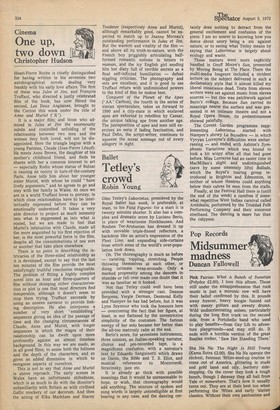Cinema
Otwnoe duop,
Christopher Hudson
Henri-Pierre Roche is chiefly distinguished for having written in his seventies two autobiographical novels dealing very frankly with his early love affairs. The first of these was Jules et Jim, and Francois Truffaut, who directed a justly celebrated film of the book, has now filmed the second, Les Deux Anglaises, brought to the Curzon this week under the title of Anne and Muriel ('X ').
It is a major film; and those who admired in Jules at Jim the enormously subtle and controlled unfolding of the relationship between two men and the woman they both loved, will not be dis appointed. Here the triangle begins with a young Parisian, Claude (Jean-Pierre Laud). He meets Anne Brown, the daughter of his mother's childhood friend, and finds he shares with her a common interest in art — especially Rodin whose statue of Balzac is causing an outcry in turn-of-the-century Paris. Anne tells him about her younger sister Muriel, with whom he could "have lively arguments," and he agrees to go and stay with her family in Wales. At once we are in a world Truffaut loves to portray, in which close relationships have to be intel lectually expressed before they can be emotionally understood. It takes a very able director to project as much intensity Into what is suppressed as into what is stated, but we are made to feel that Muriel's infatuation with Claude, made all the more anguished by his first rejection of her, is the most powerful force in the film, despite all the consummations of one sort or another that take place elsewhere.
There is no point in describing the intricacies of the three-sided relationship as it is developed, except to say that the last ten minutes of the film provide the most satisfyingly truthful conclusion imaginable. The problem of fitting a highly complex novel into an hour and three-quarters of film without skimping either characterisa tion or plot is one that most directors find insuperable, although it doesn't seem to stop them trying. Truffaut succeeds by using an unseen narrator to provide link ing description. He also interposes a number of very short ' establishing ' sequences giving an idea of the passage of time and the changing circumstances of Claude, Anne and Muriel, with longer sequences in which the stages of their relationship can be dwelt upon more profoundly against an almost timeless background. In this way we are made, as in all good films, to sense both the fullness and the depth of the characters, and so given an added dimension in which to recognise aspects of ourselves.
This is not to say that Anne and Muriel is above reproach. The early scenes in Wales have an unfortunate stiltedness, which is as much to do with the director's unfamiliarity with Britain as with civilised Gallic mockery of our decorum. And then the acting of Kika Markham and Stacey Tendeter (respectively Anne and Muriel), although remarkably good, cannot be expected to match up to Jeanne Moreau's outstanding performance in Jules at Jim. But the warmth and vitality of the film — and above all its truth-to-nature, with the French boy priggishly articulating halfformed romantic notions in letters to maman, and the icy English girl sending him her diary full of terrible secrets as a final self-inflicted humiliation — defeat niggling criticism. The photography and sets are excellent; and it is good to see Truffaut return with undiminished powers to the kind, of film he makes best.
Conquest of the Planet of the Apes (' AA ' Carlton), the fourth in the series of simian spectaculars, takes us forward to 1990 and a city-state in which enslaved apes are exhorted to rebellion by Caesar, the unique talking ape from another age. The juxtaposition of apes and men still exercises an eerie if fading fascination, and Paul Dehn, the script-writer, continues to squeeze the moral message out of every allegory in sight.














































 Previous page
Previous page